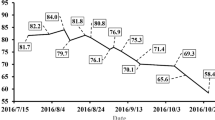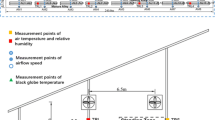Abstract
The objective of this study was to develop an equation to predict rectal temperature (RT) using body surface temperatures (BSTs), physiological and climatic variables in pubertal Holstein heifers in an arid region. Two hundred Holstein heifers were used from July to September during two consecutive summers (2019 and 2020). Respiratory frequency (RF) was used as a physiological variable and ambient temperature, relative humidity and temperature-humidity index as climatic variables. For the body surface temperatures, infrared thermography was used considering the following anatomical regions: shoulder, belly, rump, leg, neck, head, forehead, nose, loin, leg, vulva, eye, flank, and lateral area (right side). Initially, a Pearson correlation analysis examined the relationship among variables, and then multiple linear regression analysis was used to develop the prediction equation. Physiological parameters RT and RF were highly correlated with each other (r = 0.73; P˂0.0001), while all BST presented from low to moderate correlations with RT and RF. BST forehead temperature (FH) showed the highest (r = 0.58) correlation with RT. The equation RT = 35.55 + 0.033 (RF) + 0.030 (FH) + ei is considered the best regression equation model to predict RT in Holstein heifers in arid zones. This decision was made on the indicators R2 = 60%, RMSE = 0.25, and AIC = 0.25, which were considered adequate variability indicators.



Similar content being viewed by others
Abbreviations
- RT:
-
Rectal temperature
- BST:
-
Body surface temperature
- RF:
-
Respiration frequency
- HS:
-
Heat stress
- r :
-
Coefficient of correlation
- R 2 :
-
Coefficient of determination
- AIC:
-
Akaike information criteria
- BT:
-
Body temperature
- IRT:
-
Infrared temperature
- NOM:
-
Norma Oficial Mexicana (Official Mexican Standards)
- AT:
-
Ambient temperature
- RH:
-
Relative humidity
- THI:
-
Temperature-humidity index
- FH:
-
Forehead
- RMSE:
-
Root mean square error
- CV:
-
Coefficient of variation
- bpm:
-
Breaths per minute
- MLRE:
-
Multiple linear regression equations
- DW:
-
Durbin-Watson
- DFFITS:
-
Difference in fits
- DFBETAS:
-
Difference in betas
- Q-Q:
-
Quantile–quantile
- PRESS:
-
Predicted residual error sum of squares
References
Ammer S, Lambertz C, Gauly M (2017) Comparison of different measuring methods for body temperature in lactating cows under different climatic conditions. J Dairy Res 83:165–172. https://doi.org/10.1017/S0022029916000182
Armstrong DV (1994) Heat stress interaction with shade and cooling. J Dairy Sci 77:2044–2050. https://doi.org/10.3168/jds.S0022-0302(94)77149-6
Avendaño-Reyes L (2014) Heat stress management for milk production in arid zones. Chapter 9. In: Narongsak Chaiyabutr (eds.), Milk Production an up-to-date overview of animal nutrition, management and health. Intechopen Inc. pp 165–184. https://doi.org/10.5772/51299
Berman A (2006) Extending the potential of evaporative cooling for heat-stress relief. J Dairy Sci 89:3817–3825. https://doi.org/10.3168/jds.S0022-0302(06)72423-7
Bernabucci U, Biffani S, Buggiotti L, Vitali A, Lacetera N, Nardone A (2014) The effects of heat stress in Italian Holstein dairy cattle. J Dairy Sci 97:471–486. https://doi.org/10.3168/jds.2013-6611
Boehmer BH, Pye TA, Wettemann RP (2015) Ruminal temperature as a measure of body temperature of beef cows and relationship with ambient. Appl Anim Sci 31:387–393. https://doi.org/10.15232/pas.2014-01336
Caja G, Salama AAK, Rovai M, Flores C, Aguiló J (2014) Thermographic variation of the udder of dairy ewes in early lactation and following an Escherichia coli endotoxin intramammary challenge in late lactation. J Dairy Sci 97:1377–1387. https://doi.org/10.3168/jds.2013-6978
Chung T, Jung W, Nam E, Kim J, Park S, Hwang CY (2010) Comparison of rectal and infrared thermometry for obtaining body temperature of gnotobiotic piglets in conventional portable germ free facility. Asian-Aust J Anim Sci 23:1364–1368. https://doi.org/10.5713/ajas.2010.90507
Collier RJ, Gebremedhin KG (2015) Thermal biology of domestic animals. Annu Rev Anim Biosci 3:513–532. https://doi.org/10.1146/annurev-animal-022114-110659
Collier RJ, Renquist BJ, **ao Y (2017) A 100-year review: stress physiology including heat stress. J Dairy Sci 100:10367–10380. https://doi.org/10.3168/jds.2017-13676
Daltro S, Fischer V, Priscila E, Alfonzo M, Dalcin C, Stumpf MT, Kolling GJ, Gualberto V, McManus C (2017) Infrared thermography as a method for evaluating the heat tolerance in dairy cows. Rev Bras Zoot 46:374–383. https://doi.org/10.1590/S1806-92902017000500002
De Andrade FR, Mogollón Garcia HD, Vallejo Aristizábal VH, de Souza NC, Veríssimo CJ, Sartori JR, Sartori R, Pinheiro Ferreira JC (2017) Thermoregulatory responses of Holstein cows exposed to experimentally induced heat stress. J Therm Biol 66:68–80. https://doi.org/10.1016/j.jtherbio.2017.03.014
de Freitas ACB, Quirino CR, Bartholazzi JA, Vega WHO, David CMG, Geraldo AT, Rua MAS, Rojas LFC, de AlmeidaFilho JE, Dias AJB (2018) Surface temperature in different anatomical regions of ewes measured by infrared thermography. Liv Sci 216:84–87. https://doi.org/10.1016/J.LIVSCI.2018.07.014
Fabris TF, Laporta J, Skibiel AL, Corra FN, Senn BD, Wohlgemuth SE, Dahl GE (2019) Effect of heat stress during early, late, and entire dry period on dairy cattle. J Dairy Sci 102:5647–5656. https://doi.org/10.3168/jds.2018-15721
George WD, Godfrey RW, Ketring RC, Vinson MC, Willard ST (2014) Relationship among eye and muzzle temperatures measured using digital infrared thermal imaging and vaginal and rectal temperatures in hair sheep and cattle. J Anim Sci 92:4949–4955. https://doi.org/10.2527/jas2014-8087
Godyn D, Herbur E, Walczak J (2013) Infrared thermography as a method for evaluating the welfare of animals subjected to invasive procedures – a review. Ann Anim Sci 13:423–434. https://www.izoo.krakow.pl/en/periodicals
Hahn G (1999) Dynamic responses of cattle to thermal heat loads. J Dairy Sci 82:10–20. https://doi.org/10.2527/1997.77suppl_210x
Hoffmann G, Schmidt M, Ammon C, Rose-Meierhöfer S, Burfeind O, Heuwieser W, Berg W (2012) Monitoring the body temperature of cows and calves using video recordings from an infrared thermography camera. Vet Res Commun 37:91–99. https://doi.org/10.1007/s11259-012-9549-3
INEGI (2016) Instituto Nacional de Estadística y Geografía. Available in: http://cuentame.inegi.org.mx/monografias/informacion/bc/poblacion/distribucion.aspx?tema=me&e=02. Accessed 10 Aug 2020
Johnson SR, Rao S, Hussey SB, Morley PS, Traub-Dargatz JL (2011) Thermographic eye temperature as an index to body temperature in ponies. J Equine Vet Sci 31:63–66. https://doi.org/10.1016/j.jevs.2010.12.004
Kessel L, Johnson L, Arvidsson H, Larsen M (2010) The relationship between body and ambient temperature and corneal temperature. Invest Ophthalmol vis Sci 51:6593–6597. https://doi.org/10.1167/iovs.10-5659
Lee CN, Gebremedhin KG, Parkhurst A, Hillman PE (2015) Placement of temperature probe in bovine vagina for continuous measurement of core-body temperature. Int J Biometeorol 59:1201–1205. https://doi.org/10.1007/s00484-014-0931-4
Li G, Chen S, Chen J, Peng D (2020) Predicting rectal temperature and respiration rate responses in lactating dairy cows exposed to heat stress. J Dairy Sci 103:5466–5484. https://doi.org/10.3168/jds.2019-16411
Martello LS, Junior HS, Silva SL, Balieiro JCC (2010) Alternative body sites for heat stress measurement in milking cows under tropical conditions and their relationship to the thermal discomfort of the animals. Int J Biometeorol 54:647–652. https://doi.org/10.1007/s00484-009-0268-6
Martello LS, Gomes C, Ruegger R, Corte S, Leme PR (2015) Infrared thermography as a tool to evaluate body surface temperature and its relationship with feed efficiency in Bos indicus cattle in tropical conditions. Int J Biometeorol 60:173–181. https://doi.org/10.1007/s00484-015-1015-9
McManus C, Tanure CB, Peripolli V, Seixas L, Fischer V, Gabbi AM, Menegassi SRO, Stumpf MT, Kolling GJ, Dias E, Batista JGC (2016) Infrared thermography in animal production: an overview. Comput Electron Agric 123:10–16. https://doi.org/10.1016/j.compag.2016.01.027
Montgomery D, Peck E, Vining G (2006) Introducción al Análisis de Regresión Lineal. México, Ed. Limusa Wiley, 265 p., ISBN: 970–24–0327–8.
Myers RH (1990) Classical and modern regression with applications. PWS - Kent Publishing Co., Boston, MS, USA (ISBN: 0-534-92178-7)
Nääs IA, Garcia RG (2014) Infrared thermal image for assessing animal health and welfare. J Anim Behav Biometeorol 2:66–72. https://doi.org/10.14269/2318-1265/jabb.v2n3p66-72
NRC (1981) National Research Council. Effect of environment on nutrient requirement of domestic animals. National Academy Press. Washington DC, USA.
Peng D, Chen S, Li G, Chen J, Wang J, Gu X (2019) Infrared thermography measured body surface temperature and its relationship with rectal temperature in dairy cows under different temperature-humidity indexes. Int J Biometeorol 63:327–336. https://doi.org/10.1007/s00484-018-01666-x
Salles MSV, Corrêa SS, Salles FA, Roma LC, El LeniraMacLean FPA, Oliveira CE, Martello LS (2016) Map** the body surface temperature of cattle by infrared thermography. J Therm Biol 62:63–69. https://doi.org/10.1016/j.jtherbio.2016.10.003
Sathiyabarathi M, Jeyakumar S, Manimaran A, Pushpadass HA, Sivaram M, Ramesha KP, Das DN, Kataktalware MA, Jayaprakash G, Patbandha TK (2016) Investigation of body and udder skin surface temperature differentials as an early indicator of mastitis in Holstein Friesian crossbred cows using digital infrared thermography technique. Vet World 9:1386–1391. https://doi.org/10.14202/vetworld.2016.1386-1391
Schaefer AL, Cook NJ, Bench C, Chabot JB, Colyn J, Liu T, Okine EK, Stewart M, Webster JR (2012) The non-invasive and automated detection of bovine respiratory disease onset in receiver calves using infrared thermography. Res Vet Sci 93:928–935. https://doi.org/10.1016/j.rvsc.2011.09.021
Sejian V, Madiajagan B, Krishnan G (2018) Physiological adaptability of livestock to heat stress : an updated review physiological adaptability of livestock to heat stress : an updated review. J Anim Behav Biometeorol 6:62–71. https://doi.org/10.26667/2318-1265jabb.v6n3p62-71
Sellier N, Guettier E, Staub C (2014) A Review of methods to measure animal body temperature in precision farming. Am J Agric Sci Technol 2:74–99. https://doi.org/10.7726/ajast.2014.1008
Silanikove N (2000) Effects of heat stress on the welfare of extensively managed domestic ruminants. Livest Prod Sci 67:1–18. https://doi.org/10.1016/S0301-6226(00)00162-7
Sen A, Srivastava M (1990) Regression analysis. theory, methods and applications. Sr**er-Verlag. New York, USA.
Stewart M, Webster JR, Verkerk GA, Schaefer AL, Colyn JJ, Stafford KJ (2007) Non-invasive measurement of stress in dairy cows using infrared thermography. Phys Behav 92:520–525. https://doi.org/10.1016/j.physbeh.2007.04.034
Stewart M, Stafford KJ, Dowling SK, Schaefer AL, Webster JR (2008) Eye temperature and heart rate variability of calves disbudded with or without local anaesthetic. Phys Behav 93:789–797. https://doi.org/10.1016/j.physbeh.2007.11.044
Stokes JE, Leach KA, Main DCJ, Whay HR (2012) An investigation into the use of infrared thermography (IRT) as a rapid diagnostic tool for foot lesions in dairy cattle. Vet J 193:674–678. https://doi.org/10.1016/j.tvjl.2012.06.052
Tan LL, Sanjay S, Morgan PB (2016) Repeatability of infrared ocular thermography in assessing healthy and dry eyes. Cont Lens Anterior Eye 39:284–292. https://doi.org/10.1016/j.clae.2016.01.010
Vicente-Pérez R, Avendaño-Reyes L, Mejía-Vázquez Á, Álvarez-Valenzuela FD, Correa-Calderón A, Mellado M, Meza-Herrera CA, Guerra-Liera JE, Robinson PH, Macías-Cruz U (2016) Prediction of rectal temperature using non-invasive physiologic variable measurements in hair pregnant ewes subjected to natural conditions of heat stress. J Therm Biol 55:1–6. https://doi.org/10.1016/j.jtherbio.2015.11.004
Wanderley AM, Ítavo LCV, Dos Santos GT, Ítavo CCBF, Dias AM, Mateus RG, Pereira LC, Gonçalves AB, Kohl ES, Lima CRC (2020) Skin surface temperature of the mammary gland, measured by infrared thermography, in primiparous Girolando cows fed diets containing different lipid sources. J Dairy Res 87:191–195. https://doi.org/10.1017/S0022029920000333
Weschenfelder AV, Saucier L (2013) Use of infrared ocular thermography to assess physiological conditions of pigs prior to slaughter and predict pork quality variation. Meat Sci 95:616–620
Yarnell K, Fleming J, Stratton TD, Brassington R (2014) Monitoring changes in skin temperature associated with exercise in horses on a water treadmill by use of infrared thermography. J Therm Biol 45:110–116. https://doi.org/10.1016/j.jtherbio.2014.08.003
Zhang Z, Zhang H, Liu T (2019) Study on body temperature detection of pig based on infrared technology : a review. Artif Intell Agric 1:14–26. https://doi.org/10.1016/j.aiia.2019.02.002
Acknowledgements
The authors appreciate the help and permission for using the animals to Ing. Juan Carlos Reynoso (owner) and Rubén Fregoso (ranch manager), from Corrales San Carlos in Mexicali, B.C., México.
Funding
This research study was supported by the Cuerpo Académico Fisiología y Genética Animal, which belongs to the Instituto de Ciencias Agrícolas of the Universidad Autonóma de Baja California.
Author information
Authors and Affiliations
Corresponding author
Ethics declarations
Conflict of interest
The authors declare no competing interests.
Rights and permissions
Springer Nature or its licensor holds exclusive rights to this article under a publishing agreement with the author(s) or other rightsholder(s); author self-archiving of the accepted manuscript version of this article is solely governed by the terms of such publishing agreement and applicable law.
About this article
Cite this article
Theusme, C., Avendaño-Reyes, L., Macías-Cruz, U. et al. Prediction of rectal temperature in Holstein heifers using infrared thermography, respiration frequency, and climatic variables. Int J Biometeorol 66, 2489–2500 (2022). https://doi.org/10.1007/s00484-022-02377-0
Received:
Revised:
Accepted:
Published:
Issue Date:
DOI: https://doi.org/10.1007/s00484-022-02377-0




